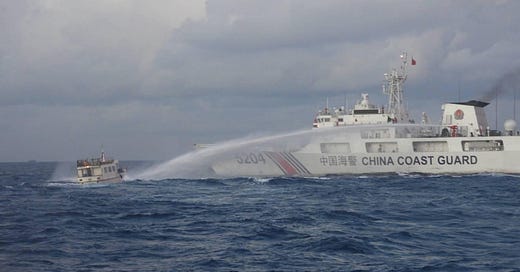Ticking South China Sea Time Bomb: How Does US Policy Fit In?
Amid looming crisis fears, China-Philippine tensions and intra-ASEAN challenges, a look at future scenarios as the clock ticks down in the regional flashpoint.
A recent book sheds light on a range of South China Sea futures and likely scenarios amid intensifying China-Philippines tensions, heightened U.S.-China competition and simmering territorial and maritime disputes.
WonkCount: 1,662 words (~8 minutes)
Ticking South China Sea Time Bomb: How Does US Policy Fit In?
Context
“[T]he Philippines will not give a single square inch of our territory to any foreign power,” President Ferdinand Marcos Jr. noted recently in a reference to China’s coercive actions against Manila in the South China Sea1. The incident marked just the latest in a seemingly endless cycle of China-Philippine tensions in the South China Sea over the past year which we have covered extensively here at ASEAN Wonk, including Taiwan sniping; new military pacts; South China Sea joint patrols; China map protests; glacial ASEAN talks; U.S.-China rivalry as well as minilateral, bilateral and inter-claimant dynamics. More broadly, these tensions are a reminder that despite rising concerns over a future Taiwan scenario, the South China Sea remains the more likely immediate Indo-Pacific flashpoint to watch in 2024, even if it has traditionally commanded relatively less attention from Washington than required2. And as anyone who has participated in war games on this question knows, the consequences could be dire, with ripple effects for the wider region and world3.
Select Key Recent South China Sea-Linked Developments
Amid this period of heightened tensions, a recent book titled On Dangerous Ground by CSIS scholar Greg Poling provides useful insights for those planning for the range of South China Sea futures and the role of U.S. policy. The book examines the trajectory of South China Sea, its interplay with global dynamics and U.S. interests as well as possible future scenarios4. In doing so, it builds on other recent works on the subject, including Bill Hayton’s The South China Sea on the history of the disputes and Marites Vitug’s Rock Solid on the Philippines’ historic legal victory over China5. On Dangerous Ground has just over 250 pages of text and ten chapters.
Analysis
The book spotlights the wider risks at play in the South China Sea and its broader regional and global implications. Though the South China Sea disputes are often narrowly viewed through the lens of U.S.-China competition, that is only the most visible and recent layer in decades-old dynamics which include shifting power balances, negotiated international principles around the freedom of the seas, regional alliance commitments and inter-claimant disagreements. On Dangerous Ground deftly weaves these South China Sea threads together while acknowledging their divergences over time6. The book does so with a rich mix of global perspective and regional granularity — from British charts in the 1800s labeling areas of the South China Sea “Dangerous Ground” (in the book’s title) to Sino-Vietnamese battles and protracted U.S.-Philippine base negotiations in the 20th century out to the current period of intensifying U.S.-China competition7. The picture that emerges is a messy one that includes Chinese revisionism, U.S. inconsistency and ASEAN’s constraints.
On Dangerous Ground also charts out the range of South China Sea futures that could emerge in the coming years, which will be useful to governments, companies and academic and research institutions alike. The book suggests three key future scenarios, with key indicators and potential implications (see table below for a brief snapshot, and the rest of the analysis section and the implications section for insights into what to watch and the prospects for the region and the world).








